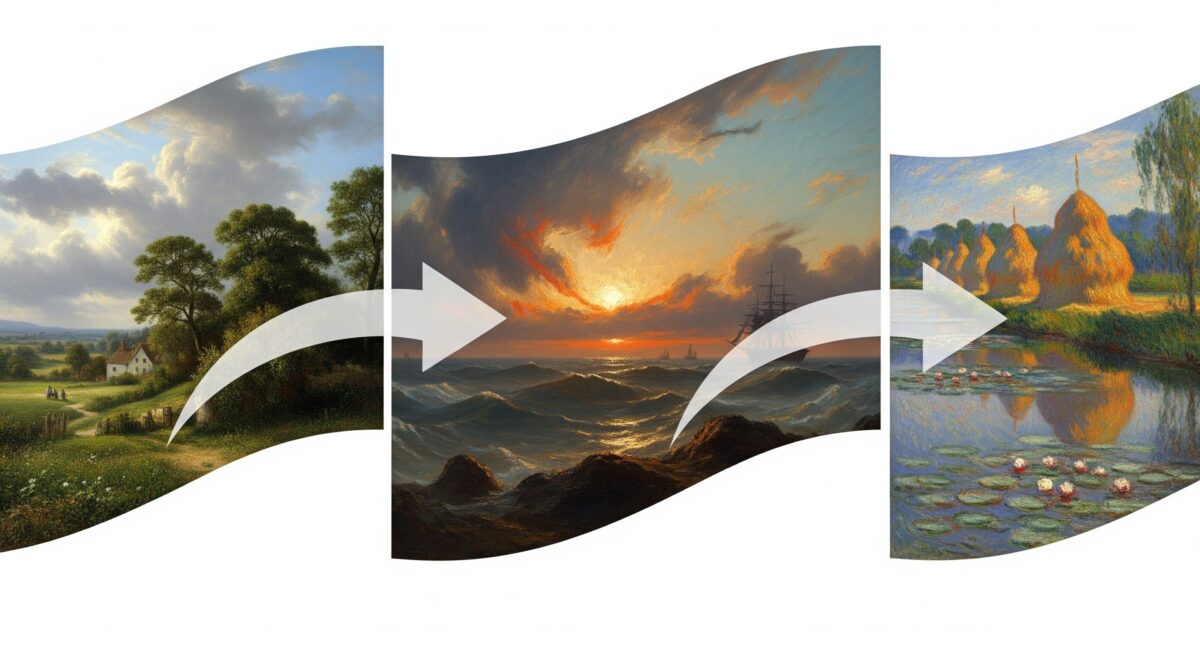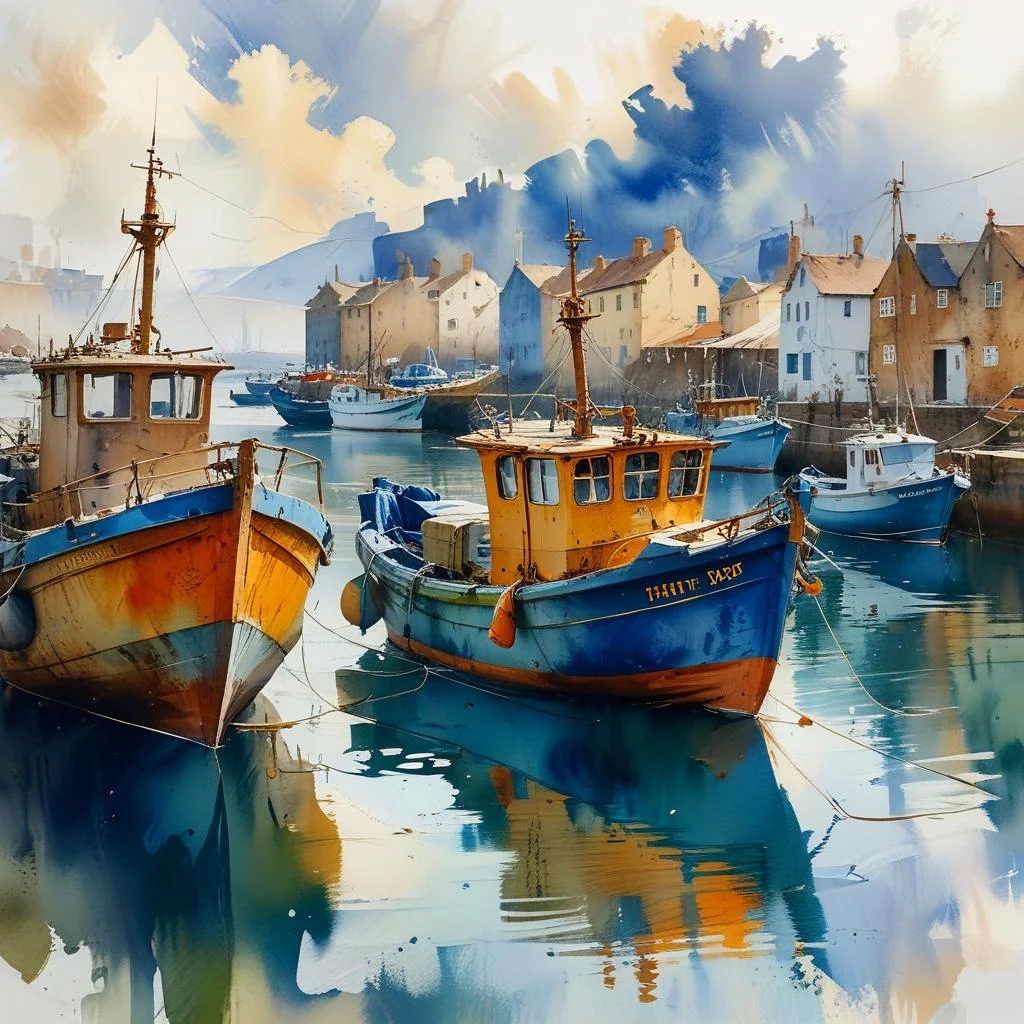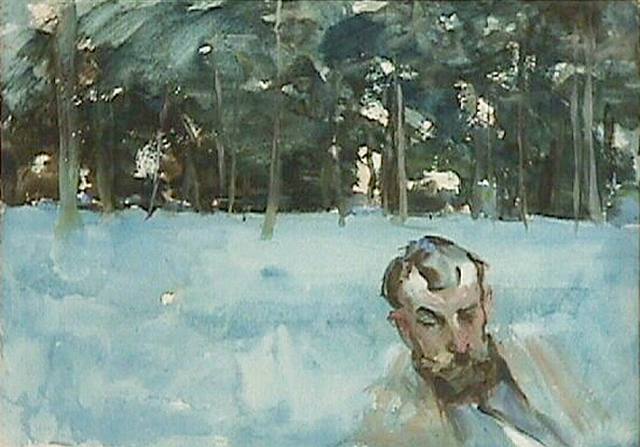The phrase Constable v Turner instantly brings to mind one of the most fascinating rivalries in British art history. This legendary competition between John Constable and J.M.W. Turner shaped 19th-century landscape painting and continues to captivate art lovers today. Their contrasting styles, dramatic confrontations at the Royal Academy, and lasting influence on modern art make this rivalry a cornerstone of art history education.
Key Points Summary:
- Artistic Rivalry: Constable v Turner represents the intense competition between two master British Romantic landscape painters
- Contrasting Styles: Constable’s realistic “earthy damp colours” versus Turner’s experimental “blazing sunsets and sublime scenes”
- Royal Academy Drama: Famous incidents including strategic painting placement and Turner’s legendary “red blob” moment
- Modern Art Influence: Both artists significantly impacted Impressionism and contemporary landscape painting
- Dual Meaning: While primarily an art reference, the phrase also appears in several legal cases
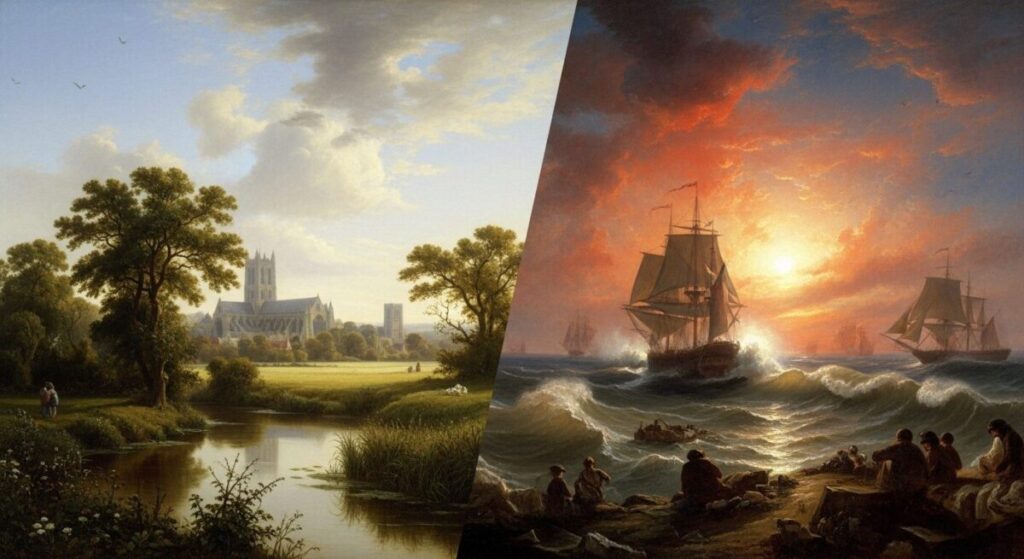
The Two Titans of British Landscape Painting
Born just one year apart, John Constable (1776-1837) and J.M.W. Turner (1775-1851) revolutionized how artists viewed and painted the natural world. Their Constable Turner rivalry wasn’t just about competition—it represented two completely different philosophies about what landscape painting could achieve.
Constable came from a comfortable Suffolk family, where his father worked as a prosperous corn merchant. This stable background influenced his grounded approach to art, focusing on familiar local scenes with scientific precision. As a family man with seven children, Constable painted the world he knew intimately.
Turner’s story was quite different. Growing up in London as the son of a wigmaker and barber, he faced early struggles that shaped his fierce independence. Unlike the respectable Constable, Turner lived an unconventional life, never marrying but maintaining relationships with several mistresses. These contrasting backgrounds created the perfect storm for their legendary artistic competition.
Realism Meets Revolutionary Light: Understanding Their Styles
The heart of Constable v Turner lies in their dramatically different approaches to painting. Understanding these differences helps explain why their rivalry became so intense and influential.
Constable’s Realistic Vision
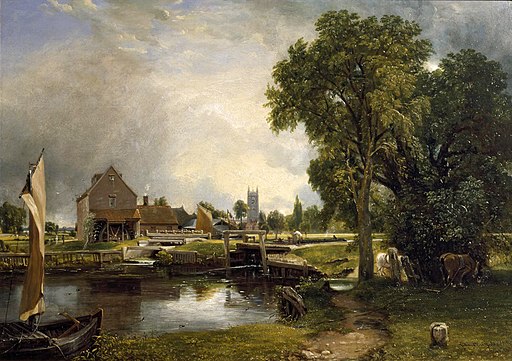
John Constable believed in capturing the “natural truth” of a scene. His paintings featured earthy damp colours that perfectly captured the English countryside’s authentic appearance. He would return to the same beloved locations around Suffolk repeatedly, studying how light and weather changed throughout different seasons and times of day.
Constable’s technique involved careful observation and precise brushwork. He wanted viewers to feel like they were standing in the actual landscape, breathing the fresh air and feeling the moisture in the atmosphere. His influence reached far beyond Britain, inspiring French artists and contributing to the development of plein air painting techniques.
Turner’s Sublime Experiments
Turner took landscape painting in a completely different direction. Rather than copying nature exactly, he interpreted its power and emotion through blazing sunsets and sublime scenes. His revolutionary use of light, color, and atmospheric effects often made his paintings appear almost abstract—radical for the 19th century.
Turner’s quick, dynamic brushstrokes and vibrant palette earned him the nickname “painter of light.” He wasn’t just showing what nature looked like; he was revealing how it felt. This approach would later influence the Impressionist movement and help pave the way for modern art. Learn more about his innovative techniques in our J.M.W. Turner artist profile.
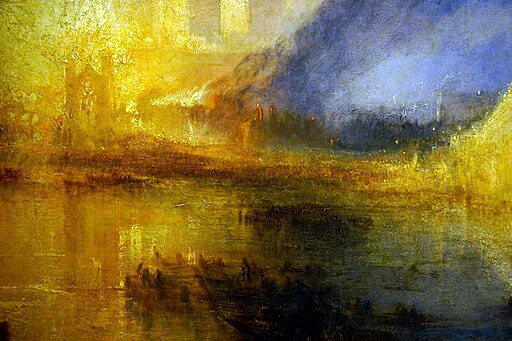
Constable vs Turner: Artistic Style Comparison
Two Masters of British Landscape Painting
| Artistic Element | John Constable (1776-1837) | J.M.W. Turner (1775-1851) |
|---|---|---|
| Color Palette | Earthy damp colours, muted greens and browns, natural tones reflecting authentic countryside | Blazing sunsets, intense yellows and oranges, vibrant contrasts with dramatic atmospheric effects |
| Brushwork | Precise, detailed strokes with careful texture work, methodical application for realistic effects | Bold, dynamic, quick brushstrokes, often loose and expressive with visible paint application |
| Subject Matter | English countryside, familiar local scenes around Suffolk, rural life and agricultural landscapes | Seascapes, dramatic landscapes, sublime natural forces, storms and maritime scenes |
| Approach to Light | Natural daylight studies, atmospheric accuracy, soft illumination capturing specific weather conditions | Experimental light effects, dramatic contrasts, light as pure emotion and spiritual experience |
| Composition Style | Balanced, traditional landscape structure following classical principles of perspective | Dynamic, often abstract arrangements focusing on movement and atmospheric dissolution |
| Philosophy | “Natural truth” – authentic representation of nature through careful observation | Emotional interpretation and sublime power of nature, prioritizing feeling over literal accuracy |
| Innovation | Plein air studies, systematic weather documentation, scientific approach to sky studies | Revolutionary color mixing, atmospheric experimentation, pioneering abstract techniques |
| Artistic Goal | Make viewers feel physically present in the actual landscape location | Convey the emotional and spiritual impact of nature’s overwhelming power |
The Royal Academy: Where Art Wars Began
The Royal Academy of Arts became the main battlefield for the Constable Turner rivalry. Both artists pursued careers there, though their paths differed significantly. Turner enrolled at age 14, had his work exhibited a year later, and became a full member at just 27. Constable entered at 22 but took much longer to achieve recognition, becoming a full member at 52—a full decade after Turner.
These career differences added fuel to their competitive fire, especially during the prestigious Summer Exhibitions where both artists displayed their latest works.
The Strategic Manipulation of 1831
In 1831, Constable served as the “hang man,” responsible for arranging paintings in the exhibition. This role gave him significant power over which artworks received prime viewing positions. Initially, he gave Turner’s Caligula’s Palace And Bridge and Vision of Medea excellent spots. However, he later swapped a central location for his own Salisbury Cathedral From The Meadows.
Turner only discovered this change after the exhibition opened to the public. This incident revealed the intense competition for visibility and the lengths artists would go to gain advantage over their rivals.
Turner’s Red Blob: The Most Famous Incident
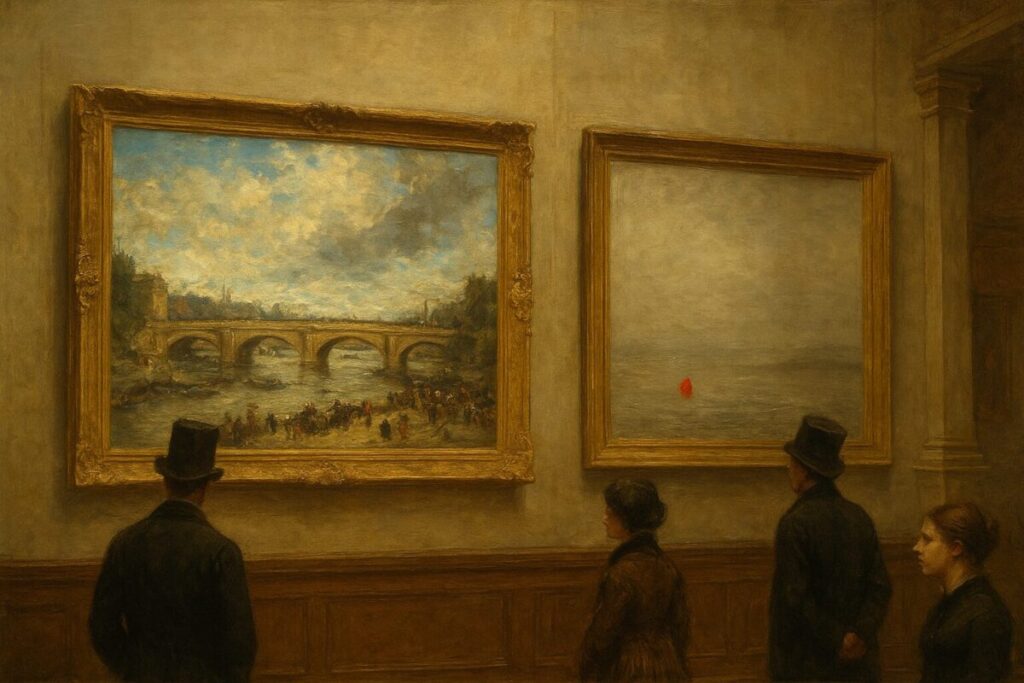
The most legendary moment in the Constable v Turner rivalry occurred at the 1832 Royal Academy Summer Exhibition. Constable had spent fifteen years perfecting The Opening of Waterloo Bridge, a vibrant celebration filled with colorful details and bustling activity. The painting was hung next to Turner’s Helvoetsluys–The City of Utrecht Going to Sea, a much more subdued, monochromatic seascape.
Just before the exhibition opened, Turner approached his painting and added a small but intensely bright red daub to his otherwise muted work. He later shaped this bold addition into a buoy, creating a focal point that dramatically drew viewers’ attention.
Constable reportedly exclaimed, “He has been here… and fired a gun!” This Turner red blob incident became legendary, demonstrating Turner’s quick thinking and competitive spirit. Many believe this audacious move successfully overshadowed Constable’s painstaking work, cementing Turner’s reputation for dramatic artistic gestures.
Their Lasting Impact on Art History
Despite their rivalry, both Constable and Turner left extraordinary legacies that continue influencing artists today. Understanding their individual contributions helps explain why the Constable v Turner story remains relevant for modern art education.
Constable’s Influence on Modern Painting
Constable’s dedication to authentic nature observation directly influenced French artists, particularly those in the Barbizon School. His emphasis on painting outdoors (en plein air) and capturing fleeting atmospheric effects helped lay the groundwork for Impressionism. Artists like Claude Monet admired Constable’s ability to show the same scene under different lighting conditions.
His scientific approach to studying skies, weather patterns, and seasonal changes also contributed to landscape painting becoming a serious artistic pursuit rather than just background decoration for other subjects.
Turner’s Revolutionary Vision
Turner’s experimental approach to light and color positioned him as a direct precursor to modern art movements. His willingness to dissolve forms into pure light and atmosphere anticipated techniques later used by Impressionists and even Abstract Expressionists.
His influence extended beyond technique to philosophy—Turner showed that landscape painting could be about emotion and interpretation rather than just documentation. This opened doors for future generations of artists to explore more expressive approaches to nature.
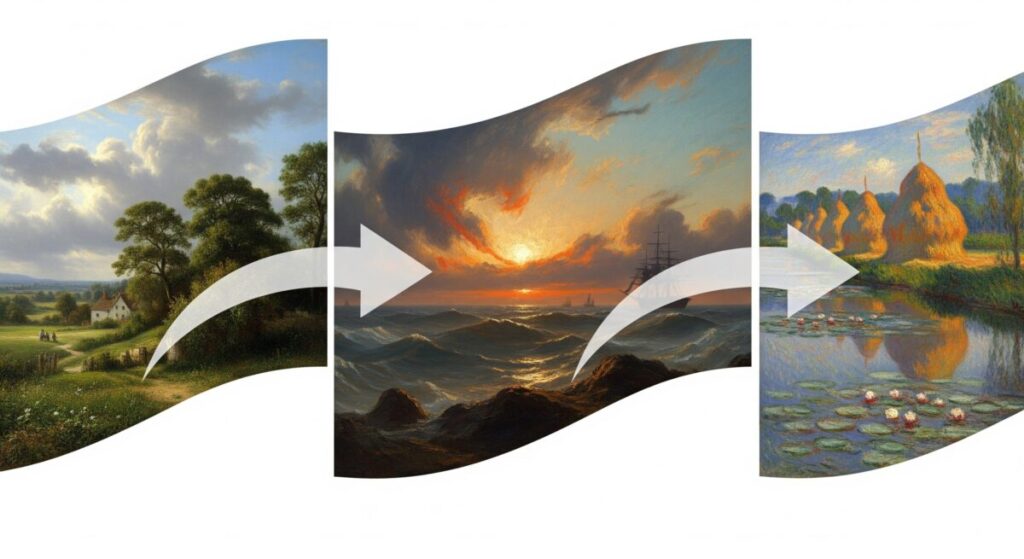
The impact of Constable and Turner on art history demonstrates how artistic competition can drive innovation and ultimately benefit the entire art world. Their contrasting approaches provided multiple pathways for future artists to explore.
Understanding the Broader Context
The Constable v Turner rivalry didn’t happen in isolation. It occurred during the Romantic period, when artists across Europe were exploring new ways to express emotion and individual vision. This movement emphasized personal experience over classical rules, making it the perfect environment for two such different artistic personalities to flourish and compete.
Their competition also reflected broader changes in British society. The Industrial Revolution was transforming the landscape they painted, making their documentation of rural England particularly poignant. Both artists, in different ways, were preserving visions of a changing world.
For more context about this artistic period, explore our comprehensive guide to Romanticism in Art, which explains how these movements shaped 19th-century creativity.
Modern Exhibitions and Continued Relevance
Today, museums frequently create exhibitions that reunite Constable and Turner’s works, allowing contemporary audiences to experience their rivalry firsthand. These displays help visitors understand how two completely different approaches to the same subject matter can both be masterful.
Art educators use the Constable Turner painting styles as perfect examples of how personal vision influences artistic expression. Students can study the same landscape painting challenges these masters faced while developing their own unique approaches.

FAQs: Constable v Turner
What does “Constable v Turner” refer to?
“Constable v Turner” primarily refers to the famous artistic rivalry between 19th-century British landscape painters John Constable and J.M.W. Turner. However, it also appears in several legal cases where individuals with those surnames were opposing parties.
How did Constable’s and Turner’s painting styles differ?
Constable focused on realistic depictions using “earthy damp colours” to capture authentic nature scenes with careful detail. Turner preferred “blazing sunsets and sublime scenes,” using bold, experimental techniques with intense colors and dynamic brushstrokes to convey emotion and atmosphere. Learn more about Constable’s approach in our John Constable artist profile.
What was the most famous incident in their rivalry?
The most famous incident occurred at the 1832 Royal Academy Exhibition when Turner added a brilliant red “blob” to his monochromatic seascape Helvoetsluys just before opening day. This bold move, later shaped into a buoy, was positioned next to Constable’s vibrant The Opening of Waterloo Bridge, effectively drawing attention away from Constable’s fifteen years of work.
How did these artists influence later art movements?
Constable’s realistic approach and outdoor painting methods significantly influenced French artists and the development of Impressionism. Turner’s innovative use of light, color, and atmospheric effects is considered a direct precursor to modern art movements, helping bridge the gap between traditional landscape painting and abstract expressionism.
What were their backgrounds and personalities like?
Constable came from a wealthy Suffolk family and lived a stable life as a married father of seven children. Turner rose from humble London beginnings as a barber’s son, living a more unconventional lifestyle as a bachelor with several relationships but never marrying. These different backgrounds influenced their contrasting artistic approaches.
How did their Royal Academy careers compare?
Turner had a much faster rise, enrolling at 14 and becoming a full member at 27. Constable entered at 22 but didn’t achieve full membership until age 52, a decade after Turner. This career difference added tension to their rivalry, especially during exhibition competitions.
Are there actual legal cases called “Constable v Turner”?
Yes, several legal cases bear this name, including Turner v. Driver (2017) regarding First Amendment rights to record police, and State v. Turner (2020) involving Ohio traffic law. However, these are coincidental and unrelated to the famous artists.
Why is their rivalry still studied today?
The Constable Turner rivalry provides an excellent case study in how different artistic visions can coexist and drive innovation. Their contrasting approaches demonstrate that there’s no single “correct” way to paint landscapes, making their story valuable for art education and understanding creative competition.
The Enduring Legacy of Artistic Competition
The Constable v Turner story continues resonating with artists, educators, and art lovers because it demonstrates how creative rivalry can push boundaries and drive innovation. Their competition didn’t destroy either artist—instead, it challenged both to refine their individual visions and contribute unique perspectives to landscape painting.
Their legacy reminds us that artistic disagreements and different approaches can coexist productively. Rather than viewing art as having one “correct” style, the Constable Turner rivalry shows how diverse techniques and philosophies can each contribute valuable insights to our understanding of creativity and nature.
Modern artists still study their techniques, museums continue displaying their works together, and art students learn fundamental principles by comparing their contrasting approaches. The Constable v Turner rivalry remains one of art history’s most compelling examples of how competition can elevate an entire artistic movement.
Additional Resources
Museums:
Royal Academy of Arts Historical Exhibitions – Royal Academy Official History (original link leads to a listing, but official detailed history is here: A brief history of the RA)
British Romantic Landscape Painting – National Gallery of Art (updated to National Gallery’s overview including Turner & Constable in the context of British painting highlights)
Constable and Turner Collection – Metropolitan Museum of Art (updated to reflect the Met’s official essay on Romanticism and its relevance to Constable & Turner)
Academic Research:
The Impact of Constable and Turner on French Impressionism – JSTOR Academic Papers (link updated to a relevant JSTOR academic paper discussing the influence of Constable and Turner on French art)
Royal Academy Exhibition Histories 1830-1840 – Chronicle250 Exhibition Archive (Apollo Magazine does not have a direct records archive; Chronicle250 provides full searchable listings for RA summer exhibitions for 1830-1839)

